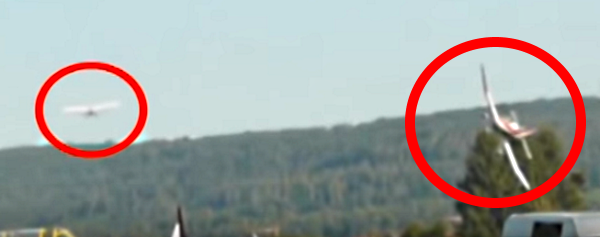According to the FAA vortices from the very largest planes generally do not drop vertically below 1000ft of the flight path. So, large aircraft flying less than 1000ft (300 meters) overhead have the potential of being felt on the ground.
This YouTube video shows a fatal aircraft accident after a medium sized prop airplane flew about 100ft above, and 40secs before the takeoff of a small plane.

The FAA addresses vortex generation and avoidance in AC_90-23G.pdf and the following information encompasses some of that information. In general, pilots are told to be weary of vortexes for 5min, 5mi, and 1000ft below. The following diagram supports this generalized rule...


Flight tests have shown that at higher altitude the vortices from large aircraft sink at a rate of several hundred feet per minute (upto 300 fpm), slowing their descent and diminishing in strength with time and distance behind the wake-generating aircraft.
6 things determining vortex strength and behavior
1) Aircraft Speed - As the velocity of an aircraft increases, the strength of the vortices is typically reduced. That's because flying faster typically requires a lower angle-of-attack. It's also why takeoff and landing are critical times to pay attention to the flight path of large aircraft around you, because they're going relatively slow and creating large vortices.
2) Aircraft Weight - The heavier the aircraft, the more lift must be produced to sustain flight. Increased lift also increases vortex strength. The A380 below is a great example of this.
3) Angle of Attack - Higher angles of attack result in stronger vortices. You have a stronger difference between low and high pressure around the wing with a high angle of attack.
4) Wing Configuration - Clean configurations result in stronger vortices, because higher angles of attack are typically needed.
5) Proximity to Ground - When your wing is close the ground, wingtip vortices can't get as big, because as they spin around your wingtip, they impact the ground and dissipate. This is a major part of ground effect.
6) Wind - While wind doesn't change the strength of vortices produced, it does impact the way vortices affect you. Wind speed and direction determines how vortices travel and dissipate. For instance, if you have a strong crosswind, the vortices produced by airplanes will float in the direction of the wind.

The aircraft was likely flying near 250-275ft altitude
most approaches are 3deg
1.5km=4920ft
.0524 = tan(3deg)
height(ft) = dist(ft) * tan(deg)
257(ft) = 4920ft(dist) * .0524 (tan(3deg))




